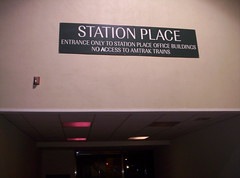Enclave development won't "save" Anacostia
 Station Place, the office complex next to Union Station, is connected directly to Union Station but residents of the area cannot walk through the building to the other side. Heralded as economic development for H Street, employees in the building serve their retail needs in Union Station. The line at the Union Station Starbucks during the day is full of office workers not wearing coats--temporary migrants from the Station Place building.
Station Place, the office complex next to Union Station, is connected directly to Union Station but residents of the area cannot walk through the building to the other side. Heralded as economic development for H Street, employees in the building serve their retail needs in Union Station. The line at the Union Station Starbucks during the day is full of office workers not wearing coats--temporary migrants from the Station Place building.Saturday's Post had this article, "Coast Guard Move Seen as SE Boon," about the latest revitalization "solution" for Anacostia (East of the River), having the Coast Guard relocate to part of the St. Elizabeth's Campus. From the article:
"City officials say moving the Coast Guard headquarters from Buzzards Point in Southwest Washington to the St. Elizabeths site could serve as a catalyst for the transformation of communities east of the Anacostia River."
How does putting a bunch of people in an enclave, disconnected from the area outside of the campus, aid revitalization? Revitalization is about connecting to and building up the area around and outside. (Remember that office workers support about 2 s.f. of retail and 5 s.f. of restaurant space.)
An enclave is an enclave, whether it is a copper mine in Chile or the Walter Reed Hospital Campus on Georgia Avenue (note that there is little substantive retail development adjacent to this site, despite the thousands of employees that work there).
In third world nations, "enclave development" is a form of "development" where an industry is built around extracting and exporting unprocessed natural resources such as ore or oil, with limited benefits to the local economy in terms of connections. In the urban revitalization sense, there are are no "mixed primary uses" (Jane Jacobs) or what Fred Kent of the Project for Public Spaces calls "layering" of complementary activities that build quality places.
 Spinoff entertainment from Shell Oil gas flares. Rumeukpe, Nigeria. Photo copyright by Friends of the Earth.
Spinoff entertainment from Shell Oil gas flares. Rumeukpe, Nigeria. Photo copyright by Friends of the Earth. 
The Coast Guard workers likely will live in the suburbs, and they won't patronize many city establishments or linger much after work. And they won't likely evince much interest in the goings on of the Greater Anacostia area in which they will work.
I have written about Anacostia in:
-- Office buildings won't "save" Anacostia
-- One more thing about Anacostia and office buildings
-- Arson as a(nother) redevelopment strategem.
It's ironic that discredited "third world" economic development strategies are heralded as revitalization boosters for minority neighborhoods in the U.S. Here's a paper I need to read about these kinds of issues: "Concepts in Social and Spatial Marginality."
A paper on India, "Development of Colonial Economy in Kerala," describes enclave development there:
These agro-processing industries which accounted for around 65% of the factory employment represented a sort of enclave development, with very little forward or backward linkages. The machinery, equipment, hardware, fuel, chemicals, etc were mostly imported and the output which required only elementary processing was almost entirely exported....All these industries, including coir, were export oriented and were dependent upon the vagaries of foreign market demand. The technology, productivity and labour process in all these industries were caught in a vicious circle of permanent stagnation. Colonial domination, the relative surplus population and the consequent availablity of cheap labour depressed the tendency of capital to constantly improve the technique of production and centralisation...
Since the production process in these industries involved only elementary or primary processing, and owing to the resultant semi-finished product nature of exports from this region, its increase by itself could not be taken as an index of industrial progress. There was very little inter-dependence between these agro-processing industries. Owing to their low technological basis, there was very little scope for the development of [indigenous] engineering or metal industries.
Anacostia provides land for development processes directed elsewhere, "with very little forward or backward linkages." Some boon. (Also see "Office ghettos aren't quality economic development.")
 Photo: Kevin Clark, The Washington Post. Phil Pannell, executive director of Anacostia Coordinating Council, (L-R) LaTesha Johnson, ANC 8A04 and Anthony Muhammad, ANC 8A are bring issues against establishments in close proximity to schools selling drug paraphernalia.
Photo: Kevin Clark, The Washington Post. Phil Pannell, executive director of Anacostia Coordinating Council, (L-R) LaTesha Johnson, ANC 8A04 and Anthony Muhammad, ANC 8A are bring issues against establishments in close proximity to schools selling drug paraphernalia. Index Keywords: urban-revitalization



0 Comments:
Post a Comment
<< Home